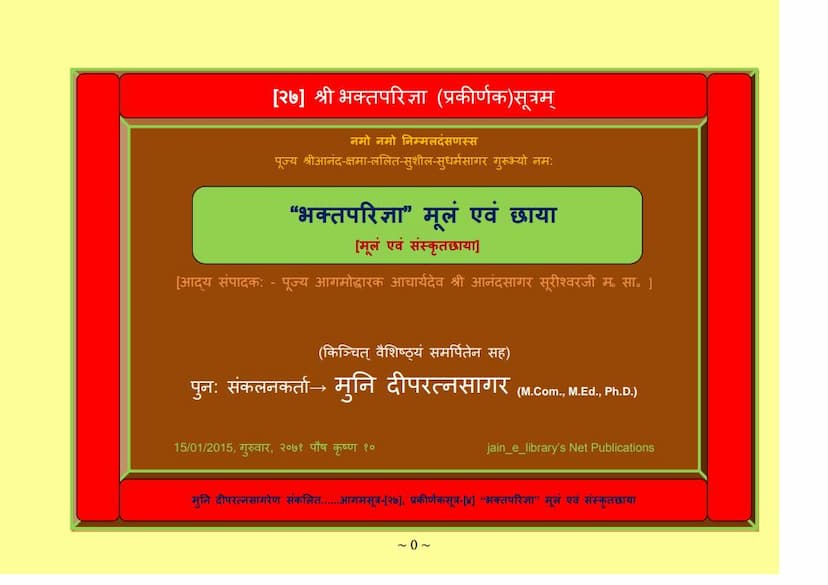Aagam 27 BHAKT PARIGYAA Moolam Evam Chhaayaa
Added to library: September 1, 2025

Summary
Here's a comprehensive summary of the Jain text "Bhakt Parigya" (Aagam 27), based on the provided pages:
Title: Aagam 27: Bhakt Parigya (Moolam evam Chhaayaa) Author/Compiler: Muni Diperatnasagar Original Editor/Reviser: Pujya Aagmoddharak Acharya Shri Anandasagar Surishwarji (Saganand Suriji) Publisher: Deepratnasagar (Originally published by Shri Agamoday Samiti) Net Publication: jain_e_library.org
Overview:
The text "Bhakt Parigya" is identified as the fourth Prakirnak (miscellaneous) scripture within the Jain Agamas (specifically, Aagam #27). It is presented in its original Prakrit (Moolam) along with a Sanskrit translation (Chhaayaa). The current edition is a compilation and re-publication by Muni Diperatnasagar, who highlights the importance of respecting the original work edited by Acharya Anandasagar Surishwarji while also updating it for modern accessibility.
Content and Themes:
The "Bhakt Parigya" primarily focuses on conduct, virtuous practices, and the path to spiritual liberation, particularly emphasizing the importance of devotion (Bhakti) and right understanding (Samyaktva). The text elaborates on various aspects of Jain spiritual discipline, including:
- Veneration of Mahavir: The text begins with an invocation and salutation to Bhagwan Mahavir, acknowledging his greatness and spiritual stature.
- The Value of the Jain Teachings (Jain Shashan): It extols the virtues of the Jain religion, calling it the "Kalpadrum" (wish-fulfilling tree) that offers supreme happiness and liberation.
- The Rarity of Human Birth and Jain Teachings: It emphasizes the difficulty of obtaining a human birth and encountering the Jain doctrine, urging adherents to make the most of this opportunity.
- The Nature of Happiness: The scripture distinguishes between transient, worldly happiness (which is ultimately sorrowful) and eternal, liberated happiness (Apavarga-sukha). It advocates for the pursuit of the latter.
- Right Faith and Conduct (Samyaktva and Charitra): A significant portion of the text stresses the importance of Right Faith (Samyaktva) as the foundation for spiritual progress. It explains that true happiness and liberation are achieved through the practice of Right Knowledge, Right Faith, and Right Conduct, as prescribed by the Jinas.
- Types of Bhakt Parigya (Devotional Practices): The text discusses various forms and practices related to devotion, including the importance of rituals, prayers, and sincere contemplation.
- The Process of Repentance and Forgiveness (Alochna and Kshama): It details the practice of confession and seeking forgiveness from spiritual guides and fellow practitioners as a means of purifying the soul.
- The Great Vows (Mahavratas): The text discusses the process of taking and upholding the Great Vows, which are fundamental to the path of a Jain monk. It also touches upon the undertaking of vows by lay followers (Deshavirata).
- The Journey of Spiritual Discipline: It illustrates the stages of spiritual practice, from initial renunciation to the ultimate attainment of liberation.
- The Importance of Right Conduct and Renunciation: The scripture emphasizes the need to control one's senses, renounces desires, and avoid attachments to worldly pleasures. It highlights the dangers of attachment to sensual desires and the negative consequences of succumbing to them.
- The Role of Devotion (Bhakti): The text repeatedly emphasizes the power of devotion to the Tirthankaras (Jinas) and other revered figures in the Jain tradition. It states that sincere devotion can lead to liberation and avert negative destinies.
- Ethical Principles: It expounds on core Jain ethical principles such as non-violence (Ahimsa), truthfulness (Satya), non-stealing (Asteya), celibacy (Brahmacharya), and non-possession (Aparigraha). It illustrates the detrimental effects of violating these principles through various examples.
- The Dangers of Delusion and Ignorance (Mithyatva): The scripture warns against the pitfalls of wrong beliefs and the ignorance that leads to suffering. It advocates for shedding these and embracing Right Faith.
- Examples and Parables: The text uses numerous examples and parables to illustrate its teachings, including stories of individuals who attained spiritual heights or suffered due to their actions.
- The Ultimate Goal: The overarching message is the pursuit of liberation (Moksha) from the cycle of birth and death, achieved through diligent spiritual practice, devotion, and adherence to the Jain teachings.
Significance of the Publication:
Muni Diperatnasagar's effort is highlighted as a way to make this important Agamic text accessible to a wider audience in a modern format. He explains the genesis of this publication, acknowledging that it is based on a previous edition from 1927 edited by Acharya Anandasagar Surishwarji. He criticizes instances where subsequent editions have erased the names of the original editor and publisher, emphasizing his own commitment to preserving the integrity and lineage of the work. The publication includes cross-references and annotations to aid the reader's understanding.
In essence, "Bhakt Parigya" is a profound treatise within Jainism that guides the practitioner on the path to spiritual purity and ultimate salvation through the cultivation of devotion, righteousness, and adherence to ethical principles.